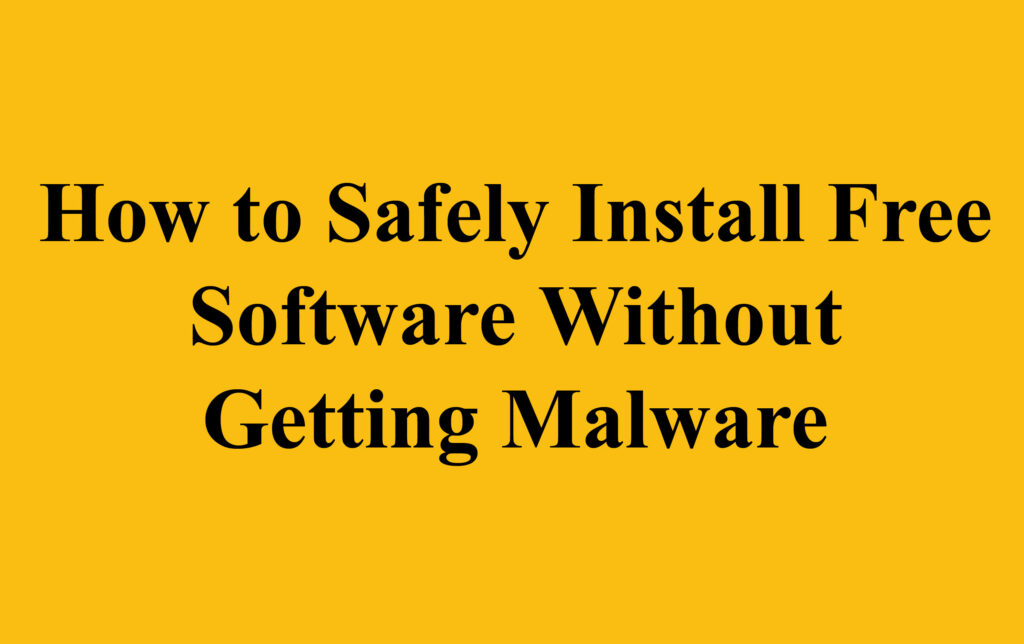🛡️ How to Safely Install Free Software Without Getting Malware
In today’s digital world, we often search for free software to help us complete tasks—editing it, managing files, or even cleaning up our PC. However, not all “free” software” e is “truly safe. Some come bundled with malware, spyware, or adware that can harm your device and compromise your data.

In this guide, we’ll provide step-by-step instructions on how to install free software safely without risking your device.
How to Turn On Real-Time Protection in Windows Security (Step-by-Step)
✅ 1. Download Only from Trusted Sources
Avoid third-party websites that are cluttered with ads and pop-ups. Instead, use:
-
The official website of the software
-
Reputable download platforms like Ninite, FileHippo, or Softpedia
Pro Tip: Double-check the domain name to avoid fake clones (e.g., “soft-pedal.c “m”).
🛠️ 2. Check User Reviews and Ratings
Before downloading, look at what other users are saying:
-
Are there complaints about malware or unwanted ads?
-
Is the software frequently updated?
Websites like Reddit, Trustpilot, and even YouTube reviews can be beneficial.
🔍 3. Scan the File Before Installing
Always scan your downloads with an antivirus. You can also use VirusTotal.com—an online tool that checks a file with over 70 antivirus engines.
Steps:
-
Go to VirusTotal.com
-
Upload the file
-
View the report before proceeding
⚠️ 4. Be Careful During Installation
Many installers bundle other software, also known as “bloatware.” “If you bli “day, click “Next.”
How to” avoid”:
-
Choose “Custom” or “advance” in “fellatio.”
-
Uncheck any unwanted software or toolbars
-
Watch out for pre-checked boxes
🔒 5. Use a Virtual Machine for Testing
If you’re unsure whether the software is 100% safe, consider installing it on a virtual machine, such as VirtualBox, first. This keeps your central system safe from potential harm.
🧹 6. Use Uninstaller Tools to Clean Up
Sometimes, the software leaves behind junk even after being uninstalled. Use tools like:
-
Revo Uninstaller
-
IObit Uninstaller
These remove hidden files, registry entries, and leftover folders.
📋 7. Keep Your System Updated
Ensure that your Windows or macOS system and antivirus software are up to date. Outdated systems are more vulnerable to malware.
🛑 8. Avoid Torrent Sites and Pirated Software
Torrent websites may offer cracked versions of paid software, but these often come with hidden malware or ransomware. Additionally, they violate copyright laws, which can cause legal trouble or even get your site penalized by Google.
Always use legal, verified sources—especially if you’re using the software for professional or business purposes.
🌐 9. Check Software Permissions (for Android or Mobile)
If you’re installing apps on Android, always review the permissions:
-
Does a simple calculator need access to your contacts or location?
-
If yes, it’s likely suspicious.
Stick to apps from Google Play Store or Apple App Store with good reviews and developer credibility.
🔐 10. Enable Real-Time Protection
Most modern antivirus software comes with real-time scanning. This feature can block malicious activity before it harms your system.
Make sure this option is turned ON in your antivirus settings.
🧑💻 11. Look for Open-Source Alternatives
Open-source tools are generally safer because their code is publicly reviewed. Popular examples:
-
LibreOffice instead of MS Office
-
GIMP instead of Photoshop
-
Audacity for audio editing
These tools are frequently audited by a community of developers, making them trustworthy.
🌐 12. Bookmark Trusted Sites
To avoid downloading from fake clone websites in the future, create a folder of trusted download sources:
-
Ninite
-
Softpedia
-
Official product pages (e.g., adobe.com, microsoft.com)
This saves time and reduces risk.
Easy Ways Step-by-Step Speed Up Windows
📌 Final Checklist Before Installing Free Software:
-
✅ Is the source official or reputable?
-
✅ Did you scan the file via VirusTotal?
-
✅ Did you read reviews?
-
✅ Did you choose “Custom Install”?
-
✅ Did you disable unwanted offers?
If all are YES, then you’re likely good to go!
🔚 Final Thoughts
Free software is a blessing when used carefully. By being a little more cautious and aware, you can protect your system, data, and peace of mind. Never compromise safety for convenience.
Ultimate Guide to Fixing Vmmem High Memory and CPU Usage on Windows
How to Get Infected With Malware (Tip: Don’t Do This)
When personal computers first became available, owning one was more of a hobby than a necessity. Users needed significant technical knowledge to troubleshoot, like reseating expansion cards or adjusting system settings in CONFIG.SYS. Fast forward to today, and computers have evolved into everyday tools, losing much of their initial excitement. However, if you’re looking to add a little thrill, why not explore the world of malware and see how it might “spice up” your digital life?
🤔 FAQs
Q: Is cracked software dangerous?
Yes, cracked software often contains hidden malware and is illegal to use. It also violates AdSense policy.
Q: What software should you use?
Open-source programs like LibreOffice, GIMP, and VLC Media Player are usually very safe and regularly updated.
📝 Final Words
Free software can be handy—but only when downloaded and installed carefully. By following the tips above, you can enjoy the benefits of free tools without risking your device or data.
If you found this helpful, share it with others or explore our safe software library!

